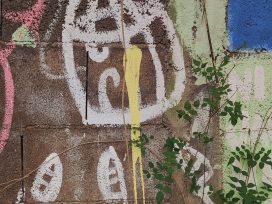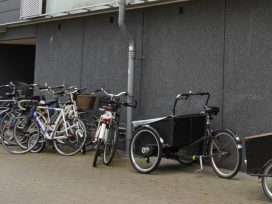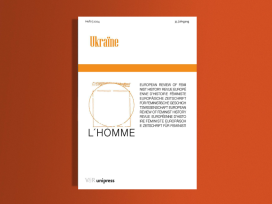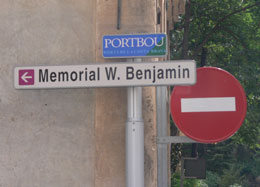 There is a sign at the foot of the hill that leads to Portbou’s cliff side cemetery, it reads: “Memorial W. Benjamin” and an arrow directs visitors to the philosopher’s grave. Next to this public notice is a “no entry” sign. Benjamin took his own life here in this coastal town on 26 September 1940, after the Spanish border police had ruled that he did not have the appropriate papers to exit Vichy France. His aim was to escape via Lisbon and join other intellectual émigrés like his friend Theodor Adorno in America. In the Hotel de Francia he wrote on a scrap of paper his final message:
There is a sign at the foot of the hill that leads to Portbou’s cliff side cemetery, it reads: “Memorial W. Benjamin” and an arrow directs visitors to the philosopher’s grave. Next to this public notice is a “no entry” sign. Benjamin took his own life here in this coastal town on 26 September 1940, after the Spanish border police had ruled that he did not have the appropriate papers to exit Vichy France. His aim was to escape via Lisbon and join other intellectual émigrés like his friend Theodor Adorno in America. In the Hotel de Francia he wrote on a scrap of paper his final message:
In a situation with no escape, I have no other choice but to finish it all. It is in a tiny village in the Pyrenees, where no one knows me, that my life must come to its end.
I would ask you to pass on my thoughts to my friend Adorno and to explain to him the situation in which I have now found myself. I no longer have enough time to write all those letters I would dearly have written.
Refused entry to Spain and unable to break free of the magnetic field of Nazi Europe Benjamin made what Marshall Berman called a “pre-emptive strike on himself”. Like many exiles he carried vials of morphine in case he arrived at just such a moment of hopelessness. The “no entry” sign that sits innocently here is a profane illumination like one of Benjamin’s “dialectical images”. As it basks in the afterglow of a Catalonian summer, the sign is a reminder of the deadly exit and entry points that were policed in this small innocuous resort town.
Led by his guide Henny Gurland, Benjamin had trekked 15 kilometres on foot from Banyul-sur-mer the day before. He crossed the mountain on the opposite side of the bay from the cemetery. It wasn’t just the physical struggle to traverse the landscape that exhausted him, but also a matter of being swallowed in dark times. Many had tried and failed to pass through this border town in the other direction, escaping Franco’s Spain. As Michael Taussig comments in his beautiful book Walter Benjamin’s Grave, Franco’s victims also haunt the region. Brutal secrets are interned in marked and unmarked graves scattered through this achingly beautiful landscape.
Arriving in Portbou, I started to look for what had already been described and take photographs that replicated ones already seen. I did this unwittingly, and not for the first time, following a course that another writer had already plotted. I had read about this place many times and journeyed here through Marshall Berman’s essay on Benjamin and Michael Taussig’s book. In a sense, I was looking for things that were already familiar, like the memorial to Benjamin called Passages by the Israeli artist Dani Karavan and the epigram that adorned it: “It is more arduous to honour the memory of the nameless than the renowned. Historical construction is devoted to the memory of the nameless.” Although I had been unable to find this evocative passage in any of Benjamin’s published works.
If you travel to a place that you have read about, there is always a point when the expectations one assimilates through reading start to pull away at themselves, as if the pages of the book need to be torn out, re-written and replaced. For Michael Taussig, this is the moment when the social reality depicted in the writing turns back on its literary facsimile and asks what has been learned and insists on a fair shake. “Reality is a shell game; our writing should be too. For a moment they interlock, but then a new pattern of ordered disorder forms, always the one before the last.”
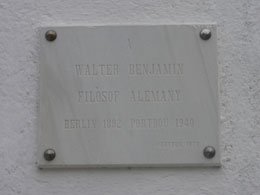 Ascending the hill, I notice the streams of iron ore that stain the dark rocky crags. Another sign bears Benjamin’s name, this time a white marble plaque laid into the wall of the Cementiri Municipal in 1979. Hannah Arendt had complained in 1940 in a letter to Gershom Scholem that “his name is not written anywhere.” She had come to pay her respects shortly after Benjamin’s suicide. Would she be consoled now? Benjamin’s name is written in Portbou but few seem to recognise it. The car park outside the cemetery is full, but not with the cars of people visiting the memorial, rather it is a convenient place to park, close to the beaches below. Franco’s generals are honoured in the street names of the town. The life of the street comes to be associated with the name erasing the person who owned it previously. They are names without a referent, an appellation without a life, a label attached to nothing. I wonder whether Benjamin’s fate is any different from the generals’.
Ascending the hill, I notice the streams of iron ore that stain the dark rocky crags. Another sign bears Benjamin’s name, this time a white marble plaque laid into the wall of the Cementiri Municipal in 1979. Hannah Arendt had complained in 1940 in a letter to Gershom Scholem that “his name is not written anywhere.” She had come to pay her respects shortly after Benjamin’s suicide. Would she be consoled now? Benjamin’s name is written in Portbou but few seem to recognise it. The car park outside the cemetery is full, but not with the cars of people visiting the memorial, rather it is a convenient place to park, close to the beaches below. Franco’s generals are honoured in the street names of the town. The life of the street comes to be associated with the name erasing the person who owned it previously. They are names without a referent, an appellation without a life, a label attached to nothing. I wonder whether Benjamin’s fate is any different from the generals’.
In this region, bodies are interned after death above ground in a “niche” for five years. The niche is then emptied and the remains are placed in a common grave or fosa común. As Taussig explains, Walter Benjamin was re-named in the Catalonian funeral rites “Benjamin Walter” and buried not as a Jew but as a Roman Catholic. On the upper tier in the graveyard there is a small garden of remembrance, a path leading to an uncut stone that bears Benjamin’s name along with the quotation: “There is no document of civilisation that is not a document of barbarism.” On top of it are stones placed by people who have come here to remember him. We place our stones and my son picks a small toy bird that is on the floor and nests it among them.
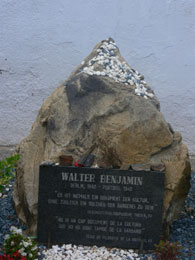 The uncut stone is a grave that is not a grave. The powders of Benjamin’s remains mingle with the rest of the nameless heaped beneath the graveyard in the fosa común. Gersholm Sholem wrote back to Hannah Arendt after her visit and claimed that the grave was apocryphal. Taussig suggests by contrast that the story of the grave is an allegory for Benjamin’s life; an existence that did not fit, a misrecognised bare life that the geopolitics of Nazism made precarious and unliveable. Walking down the stairs we pass over the rusted square plate that provides the hatch into which his remains were poured.
The uncut stone is a grave that is not a grave. The powders of Benjamin’s remains mingle with the rest of the nameless heaped beneath the graveyard in the fosa común. Gersholm Sholem wrote back to Hannah Arendt after her visit and claimed that the grave was apocryphal. Taussig suggests by contrast that the story of the grave is an allegory for Benjamin’s life; an existence that did not fit, a misrecognised bare life that the geopolitics of Nazism made precarious and unliveable. Walking down the stairs we pass over the rusted square plate that provides the hatch into which his remains were poured.
Outside the cemetery is the triangular entrance to Dani Karavan’s Passages. It was inaugurated in 1994 at the same time that the uncut stone was placed in the graveyard. Initially the memorial was commissioned by the Federal Republic of Germany to commemorate the hundredth anniversary of Benjamin’s birth in 1892. The completion of the project was delayed because the Ministry of Foreign Affairs mysteriously withdrew its funding. Although it was never admitted many believe this was because the German authorities felt uncomfortable paying for a memorial outside Germany to a secular Jew with Marxist leanings. Konrad and Ingrid Scheurmann of the Arbeitskreis selbständiger Kultur-Institute raised the 657 000 US dollars necessary to complete the project from German regional bodies and the Catalonian government. According to Karavan, Passages is a homage to the victims of Nazism and not only a memorial to a great philosopher.
Standing at the entrance of the narrow stairway made of corten steel you hear the trains in the vast railway station close by. The size of station – built by Gustave Eiffel – seems disproportionate and out of place in such a small coastal resort. In the era of the Schengen agreement and the “Eurozone”, crossing the Franco-Spanish border has little of its former significance. You no longer have to change currency or possess an exit visa. Yet the sound of the express trains having their wheels changed to Iberian gauges from standard European ones is an echo from Benjamin’s time, an eerie reminder of the transports that shipped Jews by train to the death factories at Auschwitz. Intermixed with this are the voices of tourists on the beach below and a speedboat heading for the Marina just around the headland.
Descending the stairs of Passages, the dark corridor suddenly becomes very quiet and the air is chilled by the lack of sunlight. The affect is claustrophobic and frightening. One of my children turns around and runs back up to the light. The iron walls are scratched and marked by vandals that have carved their lover’s names into the metal. Half way down, the ceiling opens to the opal sky. I catch an outline of myself reflected in the glass below and the sea. The view is breathtaking and no surprise that Hannah Arendt described it as “by far the most fantastic and most beautiful spot I have ever seen in my life.” A few more steps and a glass panel blocks the way forward. The shell game takes another turn.
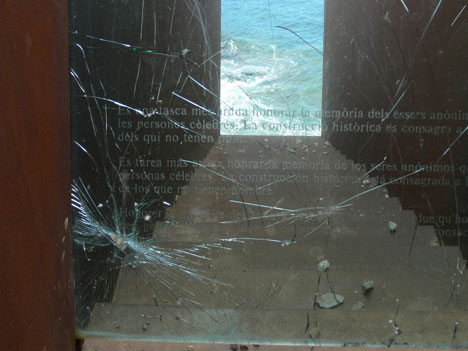
The glass has been shattered. The German lines of Benjamin’s eulogy to the nameless are clear enough and they appear as if written in the sky. However, the Spanish, Catalan, French and English translations below are unreadable through the shattered lines and shards of cracked glass. But shattered by whom? Could it have been the apologists and imitators of the Nazis? There is plenty of fascist graffiti to be found in the backstreets and doorways of Catalonia’s urban underbelly. But a closer look reveals that the glass isn’t smashed from this side. Rather, the stones are heaped up beyond the glass, it had been shattered from the other side. I imagine youths armed with rocks taking pot shots at the ruined homage from the beach below.
Should it be surprising that this homage to the nameless should end up a ruin? A memorial that isn’t touched or cared for in the act of mourning will ossify and sink into the landscape like the remains of a corpse being cleaned out of one of the niches and scraped into the fosa común. The vandalised monument is a reminder that Benjamin remained what he was all along – an anonymous target broken by human malice or the force of the wind. The stones cast against it outweigh those placed on his gravestone.
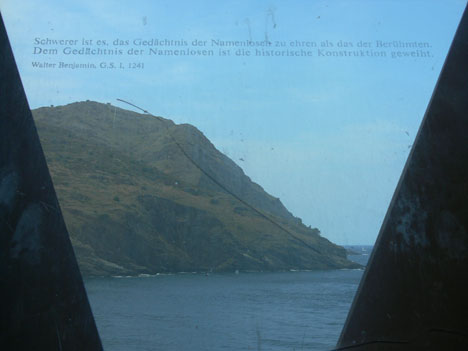
The epigram written in the sky remains a beautiful illusion. But there is another secret here and another move in the shell game. Later, I find the reference. It appears in a deleted excerpt from Benjamin’s famous last essay, the title of which in English is most commonly referred to as “Thesis on the Philosophy of History”. Benjamin never intended for the passage to be published and this is why its origin is so elusive. During the war, paper was scarce and Benjamin collected anything that he could write on. He wrote the eulogy to the nameless on the fragile orange band of the Schweizer Zeitung am Sonntag. In the recent translation of Benjamin’s complete works, the quote appears in a “paralipomena”. The new translation includes a telling fragment not present in the citation used in Karavan’s Passages.
It is more difficult to honour the memory of the anonymous than it is to honour the memory of the famous, the celebrated, not excluding poets and thinkers. The historical construction is dedicated to the memory of the anonymous. (My italics – LB.)
Benjamin would not have included himself among the nameless. Etched into the shattered glass, the philosopher’s words rather call up the trace of the disappeared people who fill countless unknown fosas along the border. These final flimsy communiqués perhaps stand in for what he may have meant by “all those letters I would have dearly written”.
On the way out of town, the coast road to the north of Portbou climbs the ragged cliffs in a sequence of tight hairpin bends. From this vantage point – on the opposite side of the bay – the scale of Karavan’s Passages is breathtaking. A huge channel carved into the landscape, a rusty indelible line that appears to be sinking into the rock. At the top of the cliff is the checkpoint that Benjamin would have crossed on his way into town. Disused now, the office where the border police stood and checked papers provides a canvass for graffiti artists. Hip-hop tags associated with the calligraphy of the New York subway smother almost every surface. The abandoned checkpoint is a relic from the order that determined Benjamin’s fate. A strange inert ruin inhabited only by the spectre of its former power. It is a reminder that the borders to Fortress Europe have shifted and that so to has the nature of their violence. The nameless today do not pass through here because the border guards have moved to them. More than this, the checkpoint is drawn around the outlines of the unwanted persons, defining their identity and ranking them within an order of humanity.
Etienne Balibar comments that Europe’s main border is marked by what he calls the South-Mediterranean Fence – both physical and virtual – it is erected to keep Africans off European soil. The Spanish fence separating the enclaves of Ceuta and Melilla on the Moroccan side of the straight of Gibraltar is a case in point. The fence has become a pressure point where the desire of sub Saharan Africans to move towards Europe is met by the physical and material efforts to keep them in their place. Thousands of migrants tried to breach it in September 2005. It is estimated that some 700 made it past the fences while six died in clashes with Moroccan security forces. Hundreds more had their hands lacerated on the barbed wire. The Spanish government of José Luis Rodríguez Zapatero responded by announcing that it would build a third fence to reinforce the two existing ones. The new 11 kilometre razor wire fence, costing Spain 33 million euros, was raised in 2005 to a height of 6 metres. Regular watchposts punctuate the stretches of wire and a road runs between the fences allowing police vehicles to patrol regularly and ambulances to tend those people who get snagged in its fortifications. Spotlights, video cameras, and noise and movement sensors all feed into the control towers of the border’s central nervous system.
There is a paradox here of another kind. Converging on Melilla and Ceuta from all over northern Africa, the migrants see themselves as moving towards Europe and not Spain or France. Sandro Mezzadra comments that African migrants are often much more enthusiastic Europeans than the EU passport holders on the mainland. Despite the white disdain for them, the migrants are perhaps the ultimate Euro-enthusiasts, willing to pay for their fervour with their own lives. As in Benjamin’s time, for the asylum seeker, movement and suicide are woven into each other, the hope of freedom is carried to the border along with fatal risk.
The bodies of drowned Africans frequently wash up on the select beaches of the Canary Islands. Africans are not very visible in Lanzarote and Fuerteventura but the bodies of those vanquished haunt the property developers who take pride in attracting a “better class” of tourist. Journalist Terry Fitzpatrick encountered an English estate agent in Puerto Rosario in 2006 who said that on two occasions his company had lost property sales because their clients had gone for a walk on the beach only to encounter washed up lifeless bodies. “There is no problem with groups of Africans in the urban centres begging, but bodies on beaches are a different matter and are most decidedly bad for business,” he concluded.
This carries me back to the sound of the beach at Portbou, Benjamin’s monument and the uneasy coexistence of seaside recreation and death.
UNITED for Intercultural Action is a Europe-wide network that raises awareness about the plight of today’s exiles. Since 1993, they have been documenting every reported case of refugee death that result from the way European borders have been controlled. UNITED encourages people in Europe to print out and display the ever-increasing list of names and the circumstances of their deaths. Today the list numbers 8855 names; by the time you read this it will be more. Listing the names is part of an ongoing living monument that attempts to ignite a spark of hope against the shadowy violence of the border. They ask: “If the death of over 8800 people does not wake up Europe’s conscience, what will?” The climate of self-satisfaction amongst European politicians and intellectuals prevents such an awakening. Perry Anderson describes the recent depictions of Europe’s success and civility as being inhibited by an “illimitable narcissism”, a kind of self-satisfied political vanity that congratulates itself on the checkpoints devoid of their power, the success of the Euro and the mobility of people within the enlarged EU. This vision of what Europe is turns away from the dark bodies being washed up on the beaches of Puerto Rosario and the faces behind the fence at Melilla. The enthusiastic proponents of a resurgent Europe, not excluding poets and thinkers, would do well to remember those words carved on Walter Benjamin’s grave: “There is no document of civilisation that is not a document of barbarism.” There is no beach that is not also a graveyard.
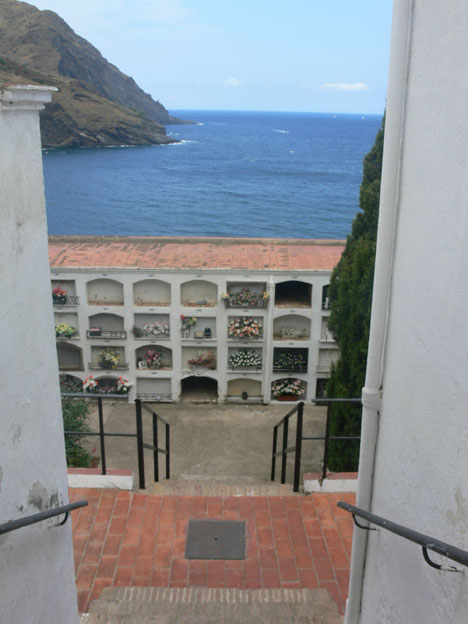
All photos by Les Back.
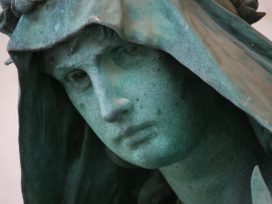
 There is a sign at the foot of the hill that leads to Portbou’s cliff side cemetery, it reads: “Memorial W. Benjamin” and an arrow directs visitors to the philosopher’s grave. Next to this public notice is a “no entry” sign. Benjamin took his own life here in this coastal town on 26 September 1940, after the Spanish border police had ruled that he did not have the appropriate papers to exit Vichy France. His aim was to escape via Lisbon and join other intellectual émigrés like his friend Theodor Adorno in America. In the Hotel de Francia he wrote on a scrap of paper his final message:
There is a sign at the foot of the hill that leads to Portbou’s cliff side cemetery, it reads: “Memorial W. Benjamin” and an arrow directs visitors to the philosopher’s grave. Next to this public notice is a “no entry” sign. Benjamin took his own life here in this coastal town on 26 September 1940, after the Spanish border police had ruled that he did not have the appropriate papers to exit Vichy France. His aim was to escape via Lisbon and join other intellectual émigrés like his friend Theodor Adorno in America. In the Hotel de Francia he wrote on a scrap of paper his final message: Ascending the hill, I notice the streams of iron ore that stain the dark rocky crags. Another sign bears Benjamin’s name, this time a white marble plaque laid into the wall of the Cementiri Municipal in 1979. Hannah Arendt had complained in 1940 in a letter to Gershom Scholem that “his name is not written anywhere.”
Ascending the hill, I notice the streams of iron ore that stain the dark rocky crags. Another sign bears Benjamin’s name, this time a white marble plaque laid into the wall of the Cementiri Municipal in 1979. Hannah Arendt had complained in 1940 in a letter to Gershom Scholem that “his name is not written anywhere.” The uncut stone is a grave that is not a grave. The powders of Benjamin’s remains mingle with the rest of the nameless heaped beneath the graveyard in the fosa común. Gersholm Sholem wrote back to Hannah Arendt after her visit and claimed that the grave was apocryphal. Taussig suggests by contrast that the story of the grave is an allegory for Benjamin’s life; an existence that did not fit, a misrecognised bare life that the geopolitics of Nazism made precarious and unliveable. Walking down the stairs we pass over the rusted square plate that provides the hatch into which his remains were poured.
The uncut stone is a grave that is not a grave. The powders of Benjamin’s remains mingle with the rest of the nameless heaped beneath the graveyard in the fosa común. Gersholm Sholem wrote back to Hannah Arendt after her visit and claimed that the grave was apocryphal. Taussig suggests by contrast that the story of the grave is an allegory for Benjamin’s life; an existence that did not fit, a misrecognised bare life that the geopolitics of Nazism made precarious and unliveable. Walking down the stairs we pass over the rusted square plate that provides the hatch into which his remains were poured.




